Overview of species and popular varieties of lilies
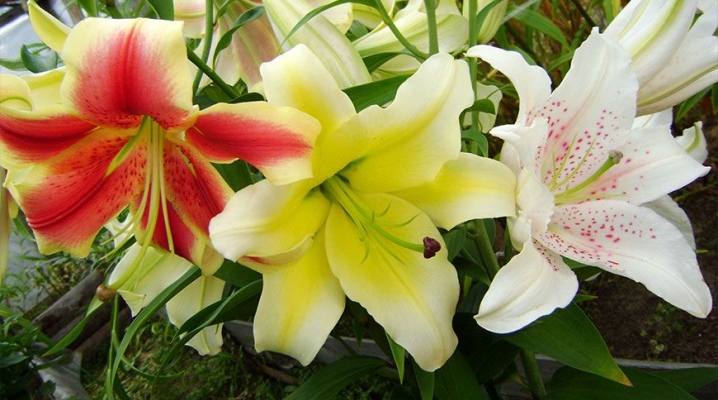
Lily is a delicate and romantic flower that many gardeners grow on their site. However, not all of them know which type of lily is suitable for growing in a particular climate. The variety of its types is very great. Let's try to figure it out in more detail.
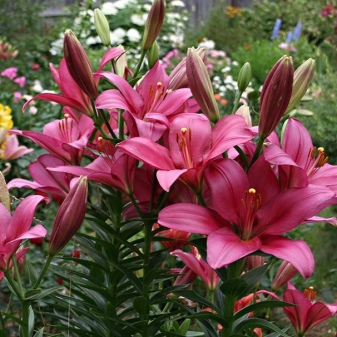
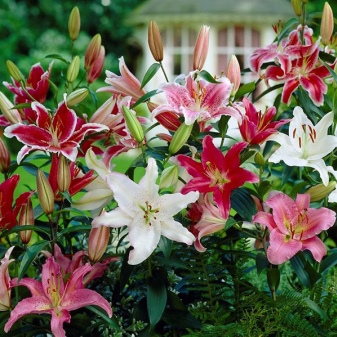
What colors are lilies?
Hybrid varieties of lilies are available in a wide range of colors. Flower petals can be light or dark, monochromatic or multi-colored, their colors can include specks, spots, streaks. There is no specially prepared classification by color, but it is customary for summer residents to divide lilies into the following varieties.
Red. These include the Black Out with bright red petals, the double fiery red Canary Wharf, or the wine-red with gilding Arabian Night flowers.
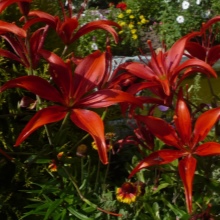
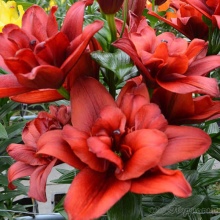
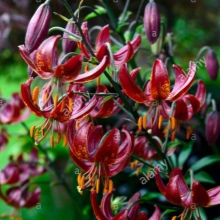
- Yellow. In this group, we can mention the Jive variety, which is valued for its lemon-yellow flowers with red strokes and light specks, the golden-yellow Golden Splendor and the honey-yellow Honey Moon.
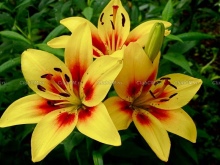

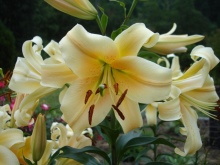
- Pink. The most popular in this group are the pink varieties "Scheherazade" and "Flashpoint".
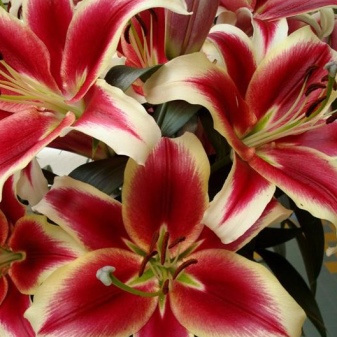
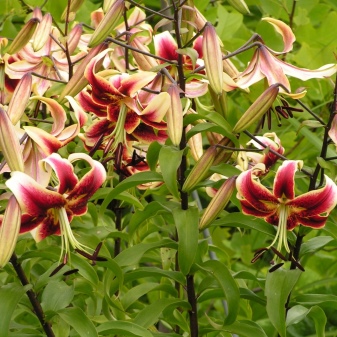
These are the most common shades of lilies. At the moment, the range of its species includes varieties with purple, lilac, red, peach, burgundy, white-pink, crimson and lilac flowers.

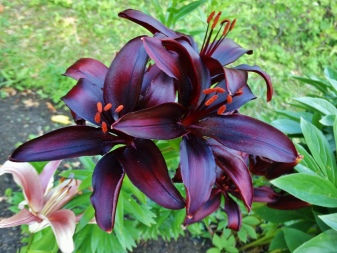
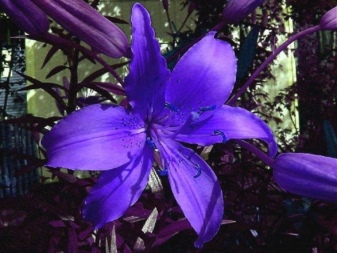
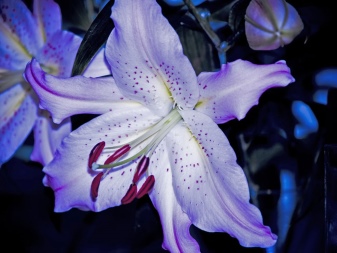
Classification
Currently, lilies are usually divided into varietal (hybrid) and species (wild). As a rule, it is not so easy to grow species plants in garden conditions, especially if a novice summer resident takes up the matter. They need to be cultivated in a greenhouse, winter and botanical gardens. But these species are used as medicinal plants.
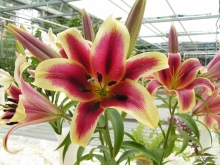
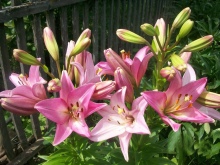
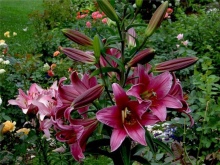
Species lilies have spreading or turban-shaped inflorescences. Their petals can also be presented in a wide variety of shades. More than a hundred subspecies are classified as wild varieties, but only 16 of them can be grown in Russia and the CIS countries. They tolerate the climatic conditions of the middle zone well, withstand sharp temperature fluctuations, and are moisture resistant.
However, wild varieties also have a significant disadvantage - it is their unpleasant smell, therefore, it is not recommended to grow such lilies for allergy sufferers. The species group includes, for example, the Leopard lily. These are turban-shaped flowers with yellow-red spotted petals. The height of the stem can reach 150 cm. Another well-known variety is the Lovely lily, which is characterized by white, pink or crimson flowers with wavy petals. The stem grows up to 120 cm, and flowering begins only in late summer or even early autumn.
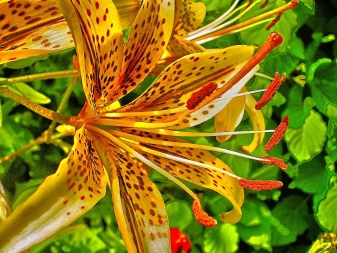
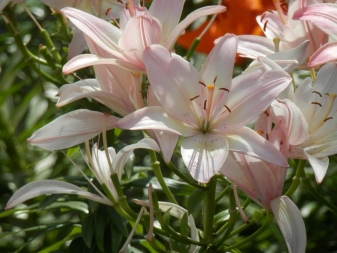
Species grown in culture
A more detailed classification of species that can be grown in a summer cottage is as follows.
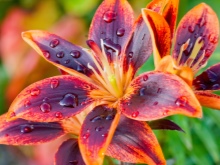
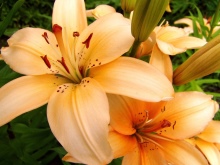
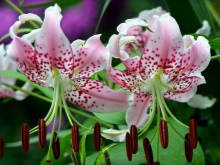
Asian
The origin of these hybrids is associated with East Asian species. The advantages of these lilies are easy reproduction, resistance to cold weather, strong immunity to fungi and viruses. The flowers are cupped and can be decorated with white, yellow, orange, pink or burgundy petals. There are almost black varieties, as well as two- and three-colored species. These are odorless lilies, therefore they are recommended for planting for those who do not like the specific aroma of lilies.
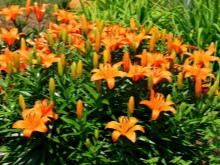
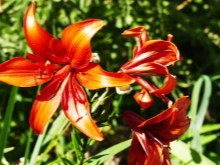
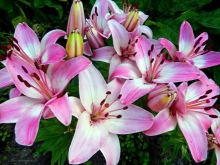
Martagon
Another name for the species is curly lilies. This name is due to the unusual shape of the flowers. The buds are down and the petals are pulled up. These flowers have a light, pleasant scent.
Of the positive qualities of these varieties, it is worth noting their frost resistance and resistance to fungal diseases. However, when planting, it should be remembered that these varieties grow rather slowly, in addition, they are negatively affected by the transplant procedure. But culture is characterized by longevity.
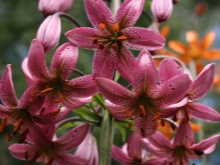
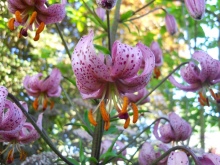
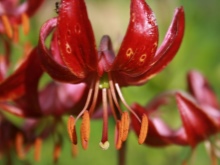
Candidum
This group includes varieties with snow-white or creamy white flowers. The shape of the buds is tubular or funnel-shaped. It is preferable to plant these species in a sunny area, since they are quite vulnerable to cold weather, for the same reason it is customary to insulate these plants for the winter. In general, these are rather capricious varieties that require increased attention. They are often infected with fungus. However, all these difficulties in growing are offset by a very beautiful flowering and fragrance.
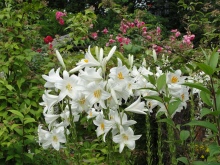
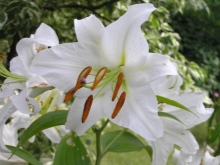
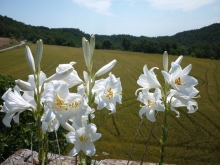
American
At home - in the United States, these flowers have not gained much popularity, but in Russia they are quite popular varieties. They are valued for their color variety and lush bloom. Usually the petals of American hybrids are two-colored. For example, on a light background, a wine-red speck can show off with a spectacular contrast. Also, the plant has a subtle, but pleasant aroma.
These flowers are not easy to grow in the garden. They are picky about climatic conditions, require regular watering, do not tolerate transplants, and therefore it is important to immediately plant them in a permanent place.
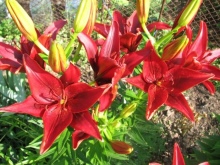
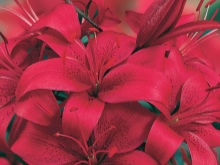
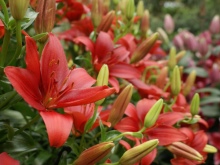
Longiflorum
These hybrids are distinguished by elongated tubular flowers, for which they are sometimes called longiflorum. Their most common color is white, and they also have a strong aroma. The buds are penetrating, directed to the sides. Long-flowered species can only grow in warm climates, so they are not suitable for cultivation in every corner of Russia, because they were originally bred in the subtropics of Japan. But they can be grown for distillation or as a potted plant.
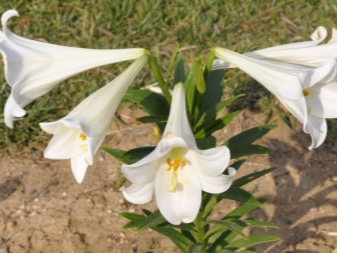
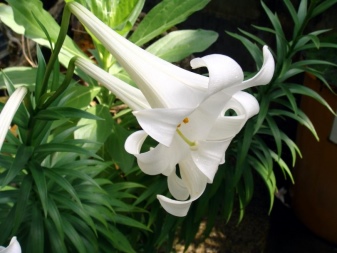
Tubular and Orleans
Flowers of this variety are elongated, as well as in the form of a cup or a star. They have a fairly wide range of colors, but yellow, orange and pink varieties are considered more popular. Their peculiarity is the darker color of the outer side of the perianth. Also, these flowers have a strong aroma.
Each bulb of this species forms two stems with flowers per year. Favorable conditions for their cultivation should be considered a sunny area and drained soil. This category is sometimes referred to as Trumpet hybrids. It includes more than a thousand varieties, although not so many species can be found in Russia.

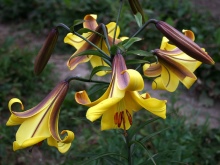
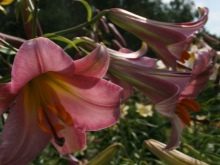
Oriental
They are characterized by a varied shape of buds. Flowers are found in tubular, goblet or turban-shaped form. It cannot be said that Oriental hybrids boast a variety of colors - they come in red, white and pink, and may include a border or stripe in the middle of the petal. Among their advantages are large flowers (15-25 cm), and the disadvantage can be considered excessive thermophilicity, due to which cultivation in many regions is difficult.

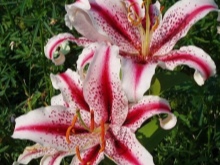
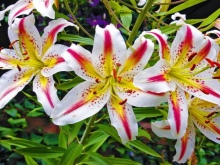
Interspecific
LA hybrids. This species appeared by crossing Asian and long-flowered varieties. It has large flowers, which are 18-25 cm wide, and massive peduncles and petals. The color of the petals is quite variable - from snow-white to burgundy. They are distinguished by good winter hardiness, but nevertheless, in some climatic zones, they need to be warmed with a layer of mulch.
OT hybrids. This is the result of the combination of oriental and tubular varieties. The diameter of the flowers is 25 cm. A pleasant aroma is characteristic of these species. The petals are either monochromatic or multi-colored. They can also survive the winter without problems, although it is recommended to build a shelter for them.Unlike many other species, they have strong immunity to diseases, but they are the ones who most often get sick with the viral mosaic.
LO hybrids. They were the result of a general selection of flowers of long-flowered and oriental species. In shape, these are tubular or funnel-shaped flowers. Mostly there are varieties with white, pink and yellow petals, and sometimes it is possible to find a flower with pink strokes or a center. This plant loves slightly acidic or neutral soil, feels comfortable both in the sun and in light shade.
OA hybrids. They are considered a descendant of Oriental and Asian hybrids. In this species, the flowers are smaller, but they cannot be called small either. Despite its compact size, the buds open very aesthetically during flowering. In addition, the advantage of such varieties is picky about the conditions of detention.

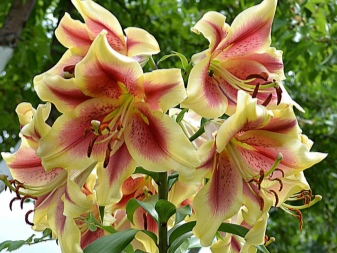
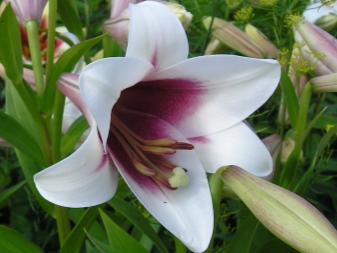
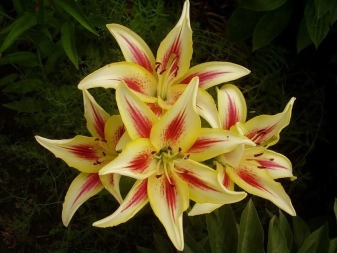
Group of wild lilies
These species reproduce well by seed. The most popular varieties are one-brother, daurian, two-row, oat, pretty, calloused, drooping, false-tiger flowers.
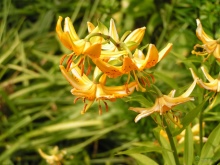
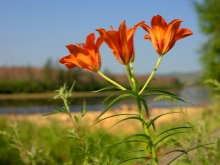
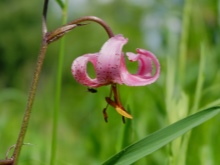
Description of the best varieties and their shades
Among the most common varieties, the following deserve special attention.
Lollipop. They belong to Asian hybrids, so they are characterized by frost resistance and good survival. The color of the petals has two shades, in the middle they are white with brown specks, and the edges are cast in crimson-pink color. In size, the petals reach 9 cm, their width is 4 cm. Flowering occurs in June-July.
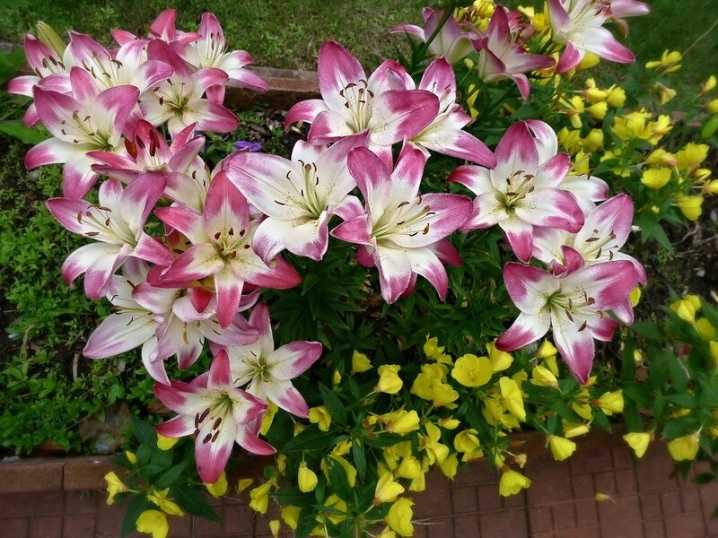
- "Mapira". Another Asian variety. The size of the plant is 90 cm. The flowers have angular, slightly twisted petals that form a star-shaped bud. Their color is maroon with lightened edges and orange stamens. It is valued for its long flowering period - June-September.
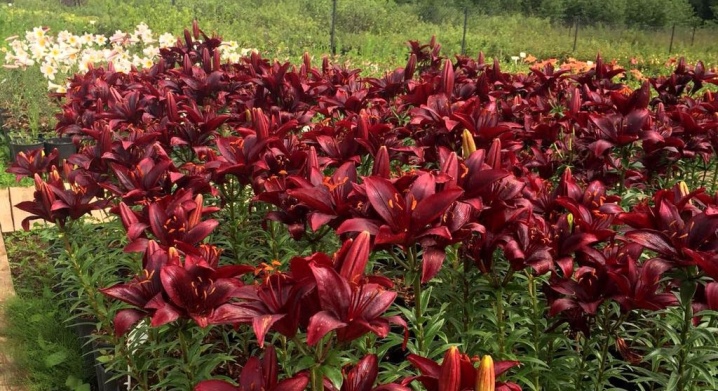
- Mystery Dream. This unusual variety with double inflorescences is distinguished by an unusual color, the petals are covered with a light green shade with burgundy stains in the center. The height of the culture is 80-90 cm, and flowering lasts from July to August.
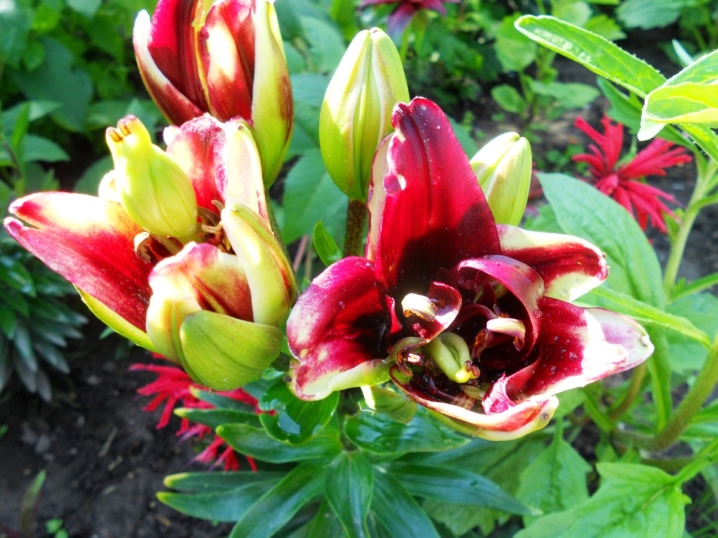
- Black Beauty. A giant plant, reaching a height of 160 cm. The dimensions of the flowers are 12 cm. The petals are painted in a bright cherry shade with a white frame at the ends. Bloom lasts from July to September. The culture belongs to OT hybrids, therefore it is characterized by a rather simple care
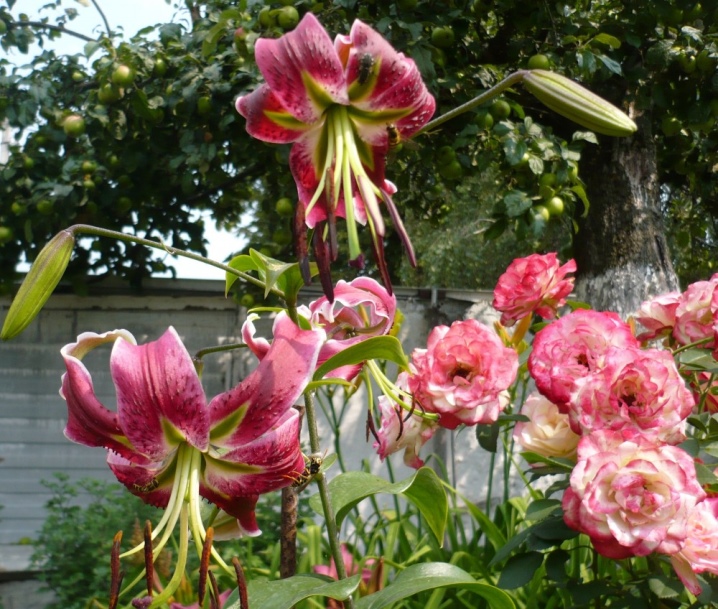
- Beverly Dream. Another OT hybrid. The diameter of the flowers of this species can reach 25 cm, and the petals are white in color with a red star-shaped spot from the center to the middle. The inflorescence contains 8-9 buds. The height of the bush is 120 cm, and the flowering period is July-August.
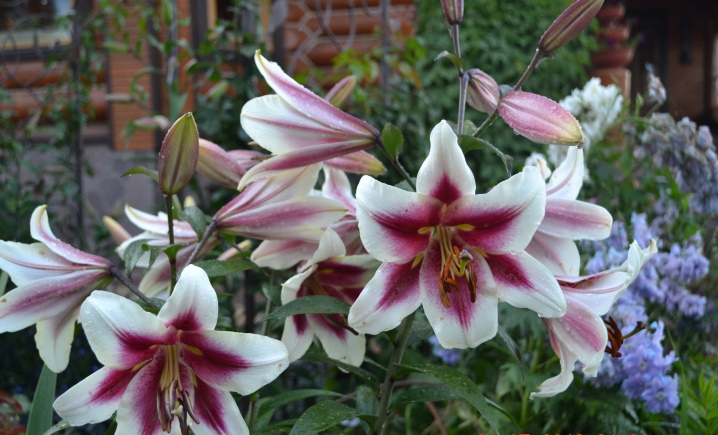
- "Kogoleto". A tall flower that grows up to 110 cm. The petals are pink with lilac tint and cherry dots. The diameter of the flower is 12-15 cm. The variety is considered to be quite unpretentious and hardy.
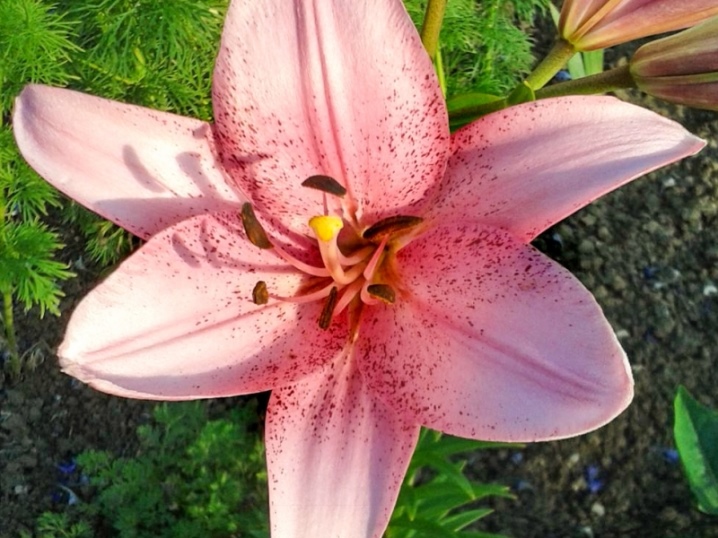
- "Lady Alice". This variety can also be found under the name "Alice". Quite a large plant, reaching a height of 120-150 cm. Flowers have a golden yellow color. Flowering begins in July and ends in August.
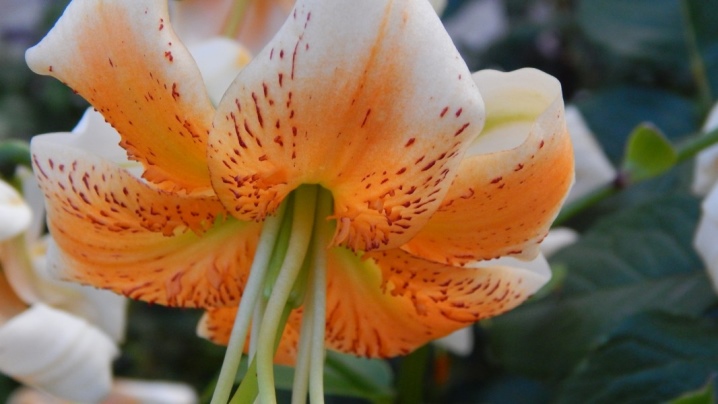
- Elodie. A representative of Asian hybrids, growing up to 120 cm, and occasionally up to 140 cm. An early variety that blooms in June and ends in July. The coloring of the petals is delicate pink and white.
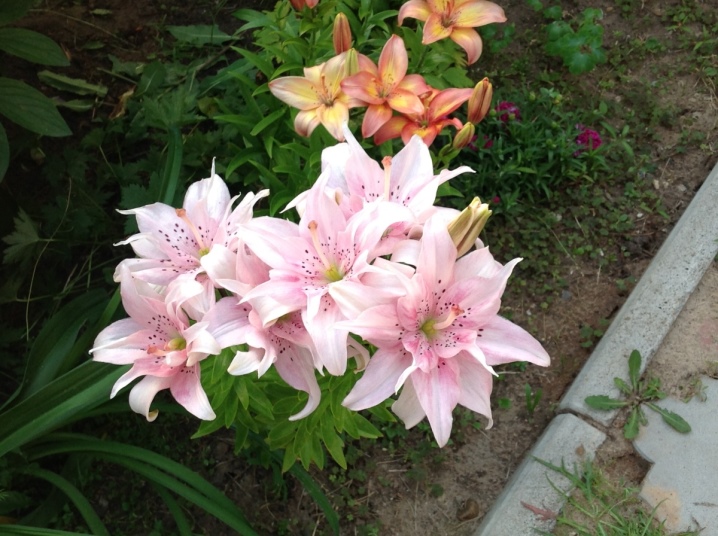
- Rising Moon. A tall plant, reaching a size of 130-140 cm. Belongs to the tubular group. The delicate creamy shade of the petals gives off a rosy blush. It has a pleasant aroma, but a short flowering period - usually this period is limited only to July.
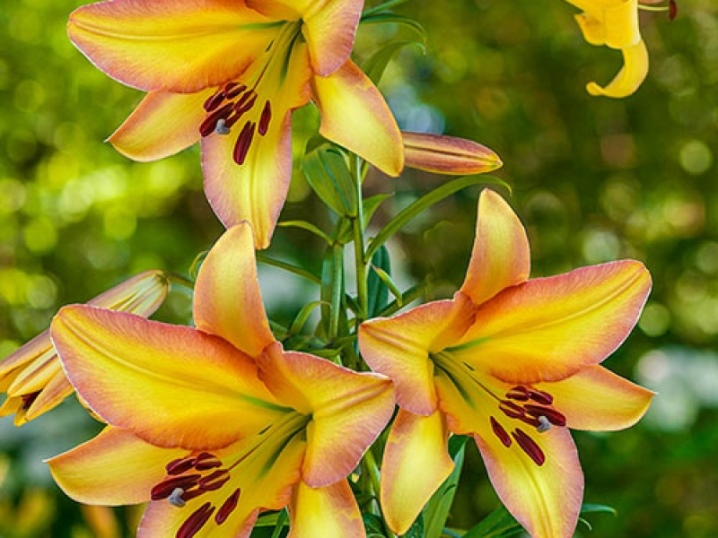
- "Purple Lady". Refers to interspecific OT hybrids. The petals, light with a yellowish tint, are bent outward, and the flower itself "looks" up. Decorated with contrasting purple stamens. The flowering period is July-August.
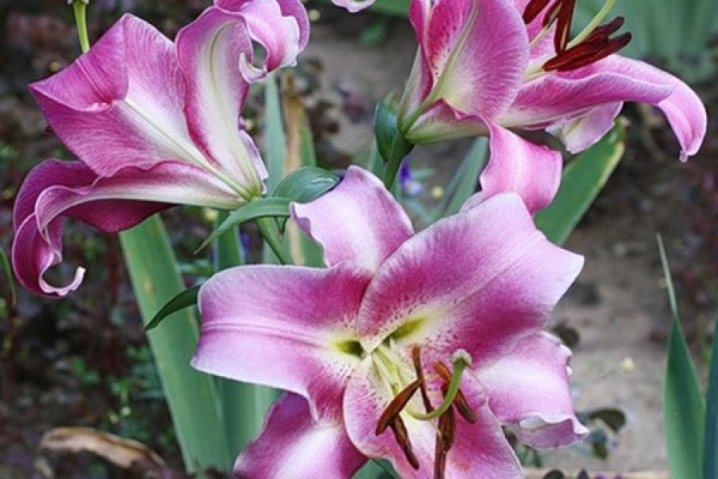
- "African Lady". A tall shrub that grows up to 100-130 cm with rich cherry flowers and yellow-creamy edging of petals.The flowering period is determined by the climatic zone, but if we talk about the middle lane, then this is mid-July - early August.
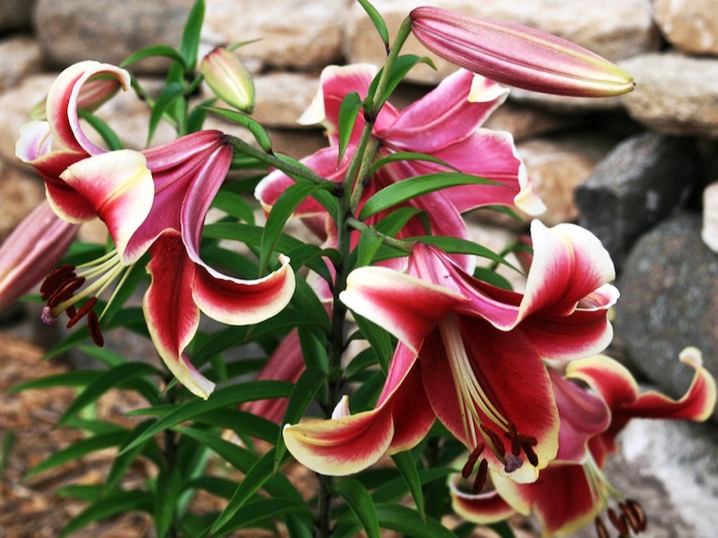
- Lavon. A giant variety, the size of which can reach 120-180 cm. Each peduncle forms up to 30 flowers with bent petals, decorated with gilding with a dark cherry stripe in the center. The flowering period is July-August.
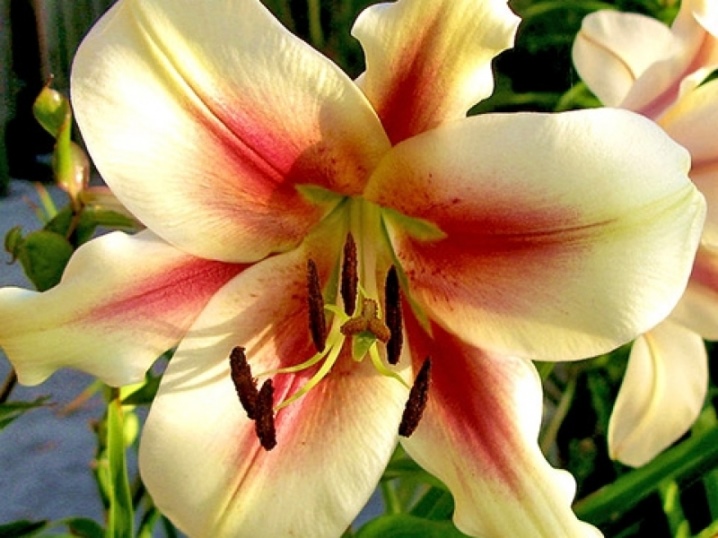
- Annemarie Dream. A compact flower, not exceeding 60 cm in height. But it has large buds - up to 15 cm in diameter. The petals are covered with a delicate white-cream shade. Blooms for 3 weeks from June to July.
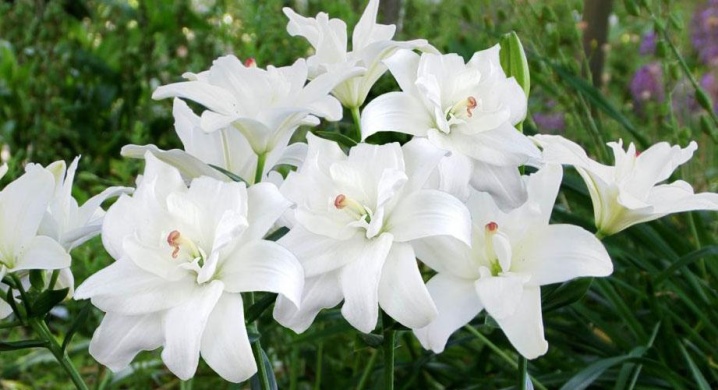
- Tabledance. Belongs to the group of OT hybrids. It has large flowers up to 25 cm in size with bright pink petals and a white center. At the edges, the petals are corrugated and gracefully bent back. Flowering lasts from July to August.
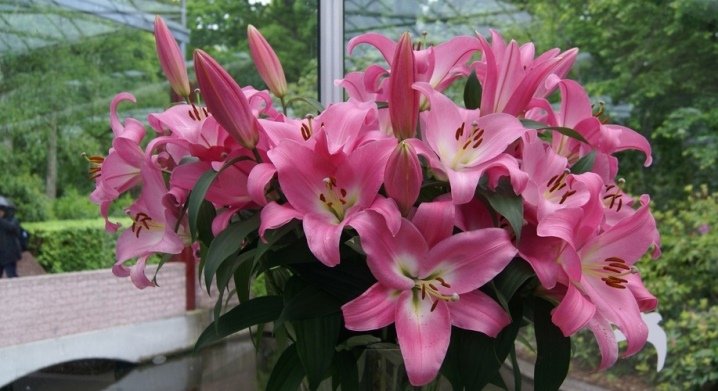
- Holland Beauty. Tall plant (up to 180 cm) from the group of OT hybrids. Large flowers with a diameter of 25 cm are covered with dark crimson petals with a cream border. Blooming in the garden, they smell pleasantly. Flowering time is August.
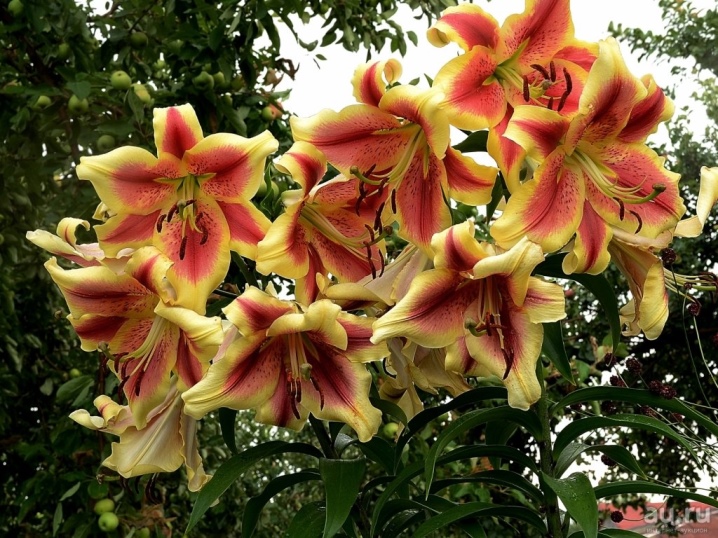
- Epricot Fudge. A variety of tulip lilies belonging to the terry LA hybrids. Obtained by crossing Asian and long-flowered varieties. The petals are salmon or bright yellow in color with a pinkish blush and green veins. The flower grows to a height of 60-100 cm, and blooms from July to August.
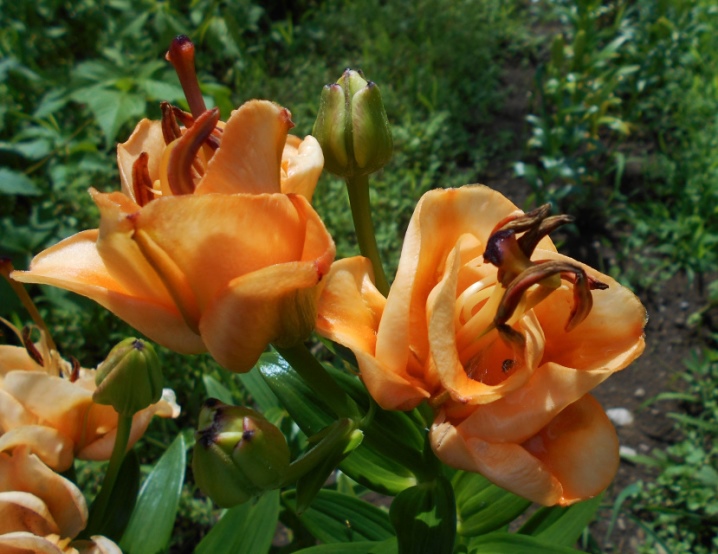
- Carmen. A variety of domestic selection, characterized by dark ruby flowers pointing up. The diameter of the flowers is 12-14 cm, and the height of the whole bush is 90-105 cm. Flowering begins in mid-June.

Truth and myths about modern hybrid varieties
Sometimes in flower shops you can see varieties and varieties of lilies called "curly", "ground cover", "climbing". You should not be interested in this product, because this move is just an advertising trap. In fact, these flowers have nothing to do with lilies, although they may outwardly very much resemble them. When choosing a variety, you should be aware that bulbous crops cannot form such a plastic stem that could curl.
The same marketing trick is lilies, in the name of which there are the words "spherical", "pyramidal", "columnar", "cone-shaped", "cascade", "tree-like". These names can describe the tall spherical variety "Marlene" and some other multi-flowered hybrids that form irregularly shaped inflorescences as a result of mutation.
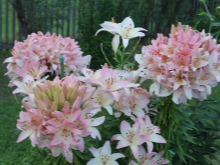
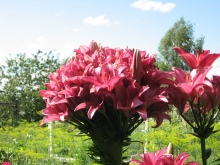
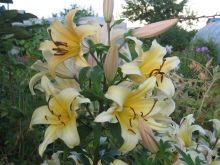
Another "enticing" move is the sale of a "bush" lily, that is, one in which several flowers are revealed at once, which is generally typical for this culture. Also, do not believe in the existence of blue and blue lilies - a real plant does not have a gene responsible for these shades.
"Lily tree" is another myth from cunning sellers. Under this name, an ordinary tall variety is sold, which really forms powerful, tall (1.5 m) shoots with large flowers, but it is still not a tree. On sale you can find a "lily of glory" - that is, a gloriosa flower. This is a beautiful plant, however, only some features of its appearance are related to the lily, and the flowers are completely different in structure.
When buying a variety in an unverified place, it is important to know that there are no annual lilies, they are all perennial. Also, do not fall for the trick regarding the medicinal effect of the plant, they all have only a decorative purpose.
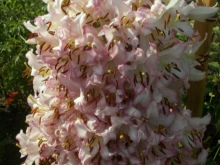

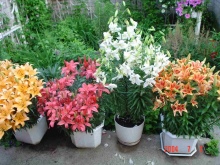
Climate zone accounting
Residents of the Arkhangelsk, Murmansk regions, Karelia and other regions belonging to the 3-4 climatic zones are often afraid to plant some types of flowers, especially without shelter. However, even in these latitudes it is possible to grow lilies, but it is important to guess with the variety. So, for such harsh conditions, for example, Asian and LA hybrids are suitable... These species are distinguished by excellent winter hardiness. Among them, there are both undersized and tall varieties, but nevertheless, it is customary to cut the flowers and cover them with a layer of mulch for the winter.


If the choice of a summer resident living in the middle lane or the Moscow region fell on long-flowered hybrids, then it is worth considering that these are thermophilic varieties, and therefore in this climate they can be planted only in a greenhouse, because their homeland is the subtropics of Japan.
Oriental species are also problematic hybrids for the middle lane, and if the gardener really wants to grow just such a variety, then it is recommended to plant it in a container. If these capricious plants take root, they will delight the grower for a maximum of 3 years, after which they will get wet due to heavy rainfall or freeze, despite high-quality insulation.
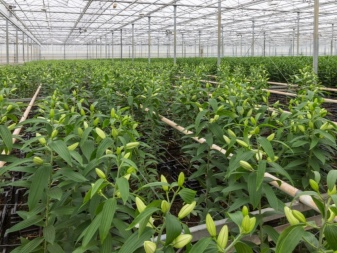
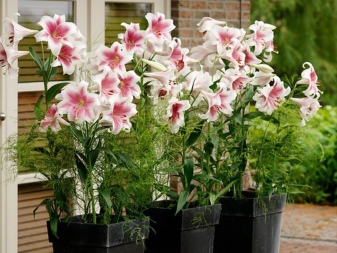
Having studied the needs of the selected variety, it can be concluded not only about the possibility of planting in a certain climatic zone, but also about the specifics of planting. If these are light-loving flowers, then they should be grown in a sunny area, and for lovers of shady places it is better to prepare a flower bed hidden from the sun.
It is also recommended to consult with experienced growers before buying planting material, they will tell you in detail about the varieties that are most suitable for the local climate. Try to avoid buying overseas varieties - they are not adapted to local conditions, it is better to buy acclimatized bulbs from breeders in your region. By the way, such a purchase will also be more economical than purchasing planting material at a visiting exhibition.
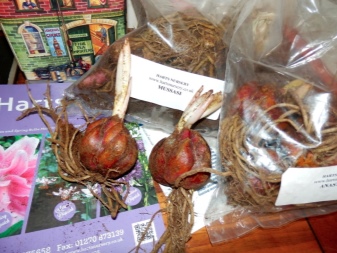
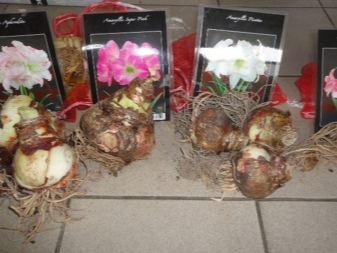
How to choose?
To choose the most successful variety, it is worthwhile to study in more detail information about all types. For example, Asian and LA hybrids are considered the most winter-hardy and unpretentious, but these varieties differ in color diversity. Asian species can please with a rich palette of colors, while LA hybrids offer an extremely limited choice, but usually the flowers of this group are larger.
OA hybrids are considered one of the rarest. They are difficult to find on sale, but if the gardener managed to notice the seedlings of this variety, then it is recommended not to miss your chance. The decorativeness of OA hybrids justifies all the difficulties of their search.
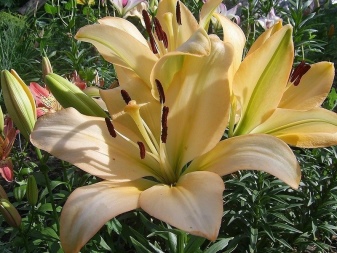
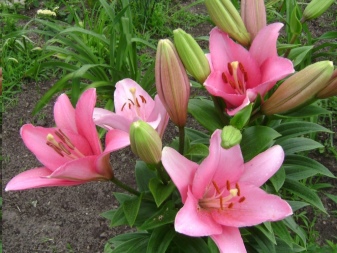
For the Moscow region, it is good to use LO hybrids, but if the flowers are planned to be planted in a more severe area, then you will need to test them. The same applies to OT hybrids - their varieties need to be tested in every case, especially in regions with short summers.
When choosing planting material, you need to study the bulb itself. Keep in mind that the larger the size, the higher the price. However, keep in mind that undersized and species lilies are always characterized by small bulbs. If it is large, this does not mean that it is necessarily healthy and of high quality - usually such samples are sold for distillation in greenhouses. As a rule, large bulbs are planting material that is in low demand due to the large supply, and there are practically no new varieties among these bulbs, despite all the assurances of the sellers.
Study the bulb carefully before purchasing. Make sure it is free of cracks, seals, rot or other defects. The scales of a healthy bulb are tightly attached to each other. Take a good look at the bottom - give preference to an instance in which it is clean and dry.
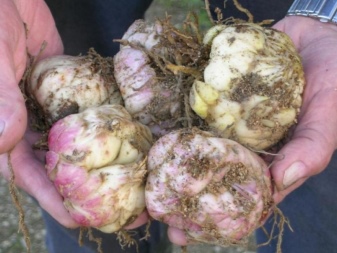
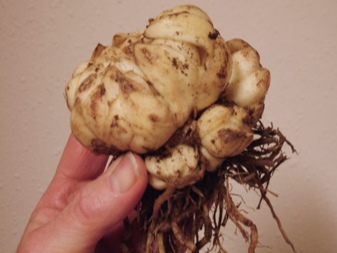
Examples in landscape design
The presented culture can be used in both single and collective planting. If this is a single composition, then varieties with golden, white, speckled, purple, tiger, red-orange, red, yellow petals are more suitable.
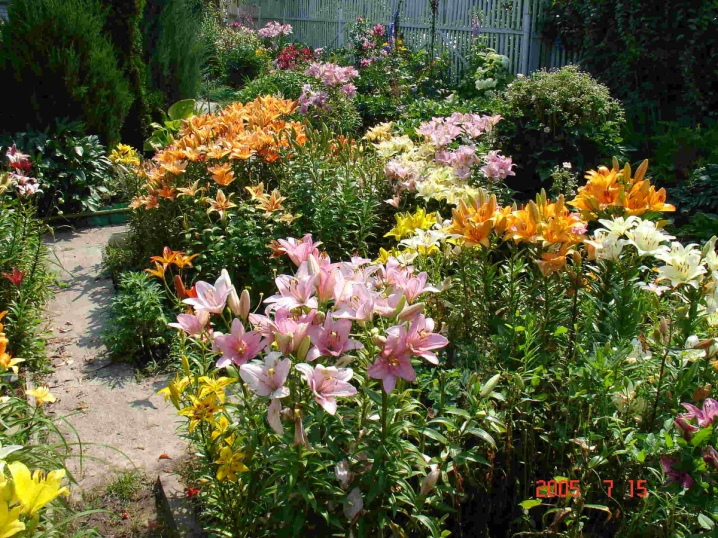
Combinations of flowers of different groups or different varieties are quite acceptable and even welcome. For example, they can be planted in several tiers. Layered compositions look impressive in the garden. At the same time, undersized species are planted in front, Asian or LA hybrids are planted behind, followed by tall varieties or OT hybrids. Such a flower garden will look very aesthetically pleasing if flowering occurs incrementally - starting from the lower level.
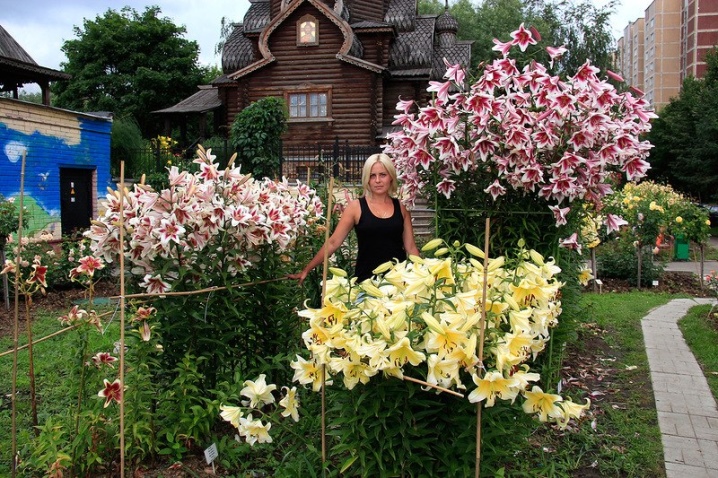
If lilies with white-pink petals are grown in the garden, then they can create a delicate tandem next to blue flowers. Such lilies will look no less impressive against the background of undersized conifers.
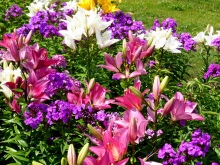
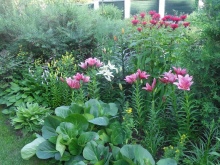
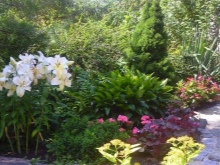
Often the lilies are surrounded by peonies, the lush foliage of which contrasts perfectly with the bright petals. If you include ground cover phlox in this composition, you get an even more picturesque landscape. Individual peony lilies also look beautiful, the petals of which are located not in two, but in three or more tiers, which outwardly resembles a peony.
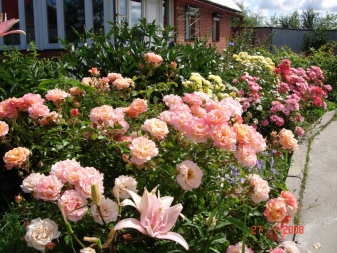

Irises are an unsuccessful combination for lilies, especially since the favorable conditions for growing these two crops differ significantly, which means that they will not feel comfort next to each other and will not be able to please with lush and abundant flowering.
For an overview of the varieties of lilies, see the video below.







































































































The comment was sent successfully.